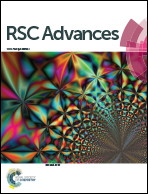Improved electrical conductivity of PDMS/SCF composite sheets with bolting cloth prepared by a spatial confining forced network assembly method
Abstract
A novel method of Spatial Confining Forced Network Assembly (SCFNA) for preparation of high-performance electrically conductive polymeric composites was proposed in this paper. Differing from the self-assembly mechanism, as in traditional compounding processes, the SCFNA process could provide conductive fillers with an effective forced networking assembly action to get a more compacted network. High electro-conductive polydimethylsiloxane (PDMS)/short carbon fiber (SCF) binary composites with a low percolation threshold of 0.15 wt% were prepared by the SCFNA method. A rapid increase in electrical conductivity from 1.71 × 10−12 S m−1 of PDMS to 1.67 × 102 S m−1 was achieved with 4 wt% short carbon fibers. It was shown that a continuous and compact SCF network was built in a PDMS matrix. Furthermore, when the bolting cloth as a sarking was co-compressed with the mixture, a much lower percolation threshold of 0.06 wt% and a higher electrical conductivity of 3.22 × 102 S m−1 with 4 wt% of SCF were obtained due to volume exclusion. Compared with the conventional compounding method, the electro-conductive properties of the composites prepared by the above mentioned method can be enhanced up to several times, or even by orders of magnitudes. Moreover, if the mesh number of the bolting cloth is large enough, the carbon fibers will be impeded from penetrating the bolting cloth together with the polymer when they are co-compressed, thus an electrically conductive film with single or double insulating face could be prepared through this method.



 Please wait while we load your content...
Please wait while we load your content...